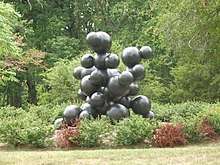Robert Chambers (sculptor)
Robert Lucas Chambers (born 1958) is an American sculptor from Miami Florida.[1] His most recent public artwork is the South Miami Dade Art and Cultural Center. 'Light Field' and 'Adze' and 'Celt'.
Robert Chambers | |
|---|---|
 Chambers' sculpture "Sugabus" (2004) | |
| Born | Robert Lucas Chambers 1958 (age 61–62) |
| Nationality | American |
| Occupation | Sculptor |
| Known for | Installations, experimentation |
| Spouse(s) | Mette Tommerup |
Background and education
He received a BFA from University of Miami in 1983 and an MA from New York University in 1990. He returned later to teach at University of Miami and New York University.[2] and is married to Danish-born painter Mette Tommerup.[3]
Collections
His sculptures appear in the permanent collections of the Kemper Museum in Kansas City, the Museum of Modern Art in New York City, and the Miami Art Museum.[1] The son of an artist mother and a molecular scientist father, Chambers often includes scientific motifs in his sculptures.[4] He describes his work as having "a sense of experimental playfulness. The rigidity of science, chemistry and physics is broken by a desire to re-contextualize empirical research thru a sculptor's vantage point. He is represented by Emerson Dorsch Gallery in Miami. "[5] Chambers has also used debris from Florida hurricanes in his work.[6]
Chambers' 2004 sculpture "Sugabus", 45 globes of bronze representing the elements of a sucrose molecule in the shape of a poodle, appears at Laumeier Sculpture Park in St. Louis, Missouri. The work's title is a portmanteau of "sugar" and Cerberus, the three-headed dog that guards the underworld in ancient Greek mythology.[1] The sculpture is 14 feet (4.3 m) x 12 feet (3.7 m) x 12 feet (3.7 m) and weights 6 short tons (5.4 t).[7]
Art Basel Miami
During Art Basel Miami in November 2007, Chambers installed a sculpture titled "Rotorelief" on roof of the Sagamore Hotel. The sculpture consisted of a working helicopter, the blades of which had been replaced by hypnotic discs.[8]
Bakehouse Art Complex
During the fall of 2018, Chambers was involved with a special hay installation, which involved creating a social area with bales of hay for an art event. He worked with a class from Florida International University to bring the project to fruition.
References
- "Sugabus, 2004". Laumeier Sculpture Park. Archived from the original on August 14, 2012. Retrieved August 14, 2012.
- "Robert Chambers Bio". robertchambers.com. Archived from the original on 14 August 2012. Retrieved August 14, 2012.
- Amei Wallach (September 16, 2001). "In Miami, a Hot Spot of Art, the Temperature's Rising". The New York Times. Archived from the original on August 14, 2012. Retrieved August 14, 2012.
- "Robert Chambers: Aesthetics & Values at the Frost Museum". Miami Art Guide. June 12, 2012. Archived from the original on August 14, 2012. Retrieved August 14, 2012.
- Robert Chambers. "Artist Statement". robertchambers.com. Archived from the original on August 14, 2012. Retrieved August 14, 2012.
- "Artists Turn Hurricane Trash Into Art Treasure". USA Today. Associated Press. May 1, 2006. Archived from the original on 14 August 2012. Retrieved 14 August 2012.
- Robert Chambers. "Sugabus". robertchambers.com. Archived from the original on August 14, 2012. Retrieved August 14, 2012.
- "Experience visual overload in Miami". NBC News. Associated Press. November 8, 1997. Retrieved August 14, 2012.